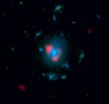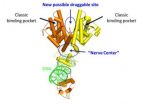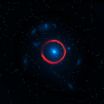(Press-News.org) Pasadena, CA — Using information gathered from several telescopes, a team of astronomers, including Carnegie's Eric Murphy, searched the sky for very rarely seen dusty starburst galaxies, formed soon after the Big Bang. These galaxies are characterized by an unusually high rate of star formation. They are much more abundant in the early Universe than previously thought. Two of those identified are among the oldest ever found, indicating that these dusty starbursts likely evolve into the most massive galaxies ever observed in the local Universe. The results are published online March 13 by Nature.
The most intense bursts of starbirth are thought to have taken place in the early Universe in massive, bright galaxies containing lots of cosmic dust. By looking far into space, at galaxies which are so distant that their light has taken many billions of years to reach us, astronomers can observe this busy period of the Universe's youth.
"The more distant the galaxy, the further back one is looking, so by measuring their distances we can piece together a timeline of how vigorously the Universe was making new stars at different stages of its 13.7 billion year life," said lead author Joaquin Vieira of the California Institute of Technology.
Obtaining detailed information about massive starbursting galaxies at such early epochs has been extremely difficult owing to the fact that they contain immense densities of dust. In the local Universe (which stretches out 380 million light years), such dusty starbursts appear to be formed by the collision of two galaxies, which powers the subsequent star genesis.
The team used data gathered from the South Pole Telescope (SPT) to select a sample of 26 potentially lensed, dusty starburst galaxies and then used the Atacama Large Millimeter Array (ALMA) to obtain both imaging and spectroscopy. The imaging data demonstrated that these sources are strongly lensed by foreground galaxies, which increases their apparent luminosities by a factor of ~10, which translates to a savings in telescope time of ~100, and allows such distant and intrinsically faint objects to be more easily detected. The spectroscopic observations provided redshifts for the sources and information on their gas content (the fuel for star formation).
From these observations, the team was able to roughly double the number of known starburst galaxies that exist in the so-called high-redshift (z > 4) Universe. A galaxy's redshift value is a measurement of how much the wavelength of the light from it that reaches Earth is stretched by the expansion of the Universe. Thus, it reveals the galaxy's age and distance. Two of the galaxies are at a redshift of 5.7, which means they formed stars 1 billion years after the Big Bang.
"This newly discovered population of high-redshift, dusty starburst galaxies will help improve our understanding of star formation in the early Universe. It demonstrates that large reservoirs of molecular gas and dust can be present in massive galaxies at very early times." Murphy said. "What's more, the fact that out of just 26 potential galaxies, we found two of the oldest starbursts ever observed bodes well for future discoveries."
The astronomers used only a partial array of 16 of ALMA's full complement of 66 giant antennas, because the observatory was still under construction. When complete, ALMA will be even more sensitive, and will be able to detect even fainter galaxies.
###
The South Pole Telescope (SPT) is a 10-meter telescope located at the National Science Foundation (NSF) Amundsen-Scott South Pole Station within 1 km of the geographic South Pole. The SPT is designed to conduct low-noise, high-resolution surveys of the sky at millimeter (mm) and submillimeter (submm) wavelengths, with the particular design goal of making ultra-sensitive measurements of the cosmic microwave background (CMB). The first major survey with the SPT was completed in October, 2011 and covers 2500 square degrees of the southern sky in three mm-wave observing bands. This is the deepest large mm-wave dataset in existence and has already led to many groundbreaking science results, including the first galaxy clusters detected through their Sunyaev-Zel'dovich effect signature, the most sensitive measurement yet of the small-scale CMB power spectrum, and the discovery of a population of ultra-bright, high-redshift, star-forming galaxies. The SPT is funded primarily by the Division of Polar Programs in NSF's Geosciences Directorate. Partial support also is provided by the NSF-funded Physics Frontier Center of the KICP, the Kavli Foundation, and the Gordon and Betty Moore Foundation.The SPT collaboration is led by the University of Chicago and includes research groups at Argonne National Laboratory, California Institute of Technology, Cardiff University, Case Western Reserve University, Harvard University, Ludwig-Maximilians-Universität, Smithsonian Astrophysical Observatory, McGill University, University of Arizona, University of California at Berkeley, University of California at Davis, University of Colorado at Boulder, University of Michigan, as well as individual scientists at several other institutions, including the European Southern Observatory and the Max-Planck-Institut für Radioastronomie in Bonn, Germany.
ALMA is a partnership of ESO, NSF, NINS, NRC, NSC and ASIAA, in cooperation with the Republic of Chile. The Joint ALMA Observatory is operated by ESO, AUI/NRAO and NAOJ. The National Radio Astronomy Observatory is a facility of the NSF, operated under co-operative agreement by Associated Universities Inc. The work is based, in part, on observations made with Herschel, a European Space Agency Cornerstone Mission with significant participation by NASA and supported through and award issued by JPL/Caltech.
This work was partially supported by NASA, the Science and Technologies Facilities Council NSERC, the CRC program and CIfAR.
The Carnegie Institution for Science is a private, nonprofit organization headquartered in Washington, D.C., with six research departments throughout the U.S. Since its founding in 1902, the Carnegie Institution has been a pioneering force in basic scientific research. Carnegie scientists are leaders in plant biology, developmental biology, astronomy, materials science, global ecology, and Earth and planetary science.
Ancient, highly active galaxies discovered
2013-03-14
ELSE PRESS RELEASES FROM THIS DATE:
ALMA finds 'monster' starburst galaxies in the early universe
2013-03-14
Astronomers using the Atacama Large Millimeter/submillimeter Array (ALMA) telescope have discovered starburst galaxies earlier in the Universe's history than they were previously thought to have existed. These newly discovered galaxies represent what today's most massive galaxies looked like in their energetic, star-forming youth. The research is the most recent example of the discoveries coming from the new international ALMA observatory, which celebrates its inauguration today.
The results, published in a set of papers to appear in the journal Nature and in the Astrophysical ...
Lower incidence of genital warts in young girls
2013-03-14
The incidence of genital warts, or condylomata, declined by 93 per cent in girls given the HPV vaccine before the age of 14, according to a Swedish national registry study. The study was carried out by researchers at Karolinska Institutet in Sweden, and published in Journal of the National Cancer Institute.
Using a selection of population-based registries, the researchers at Karolinska Institutet studied 124,000 girls and women in Sweden between 10 and 44 years old who had received the HPV vaccine against condyloma and cervical cancer at some time between 2006 and 2010. ...
Shock treatment can kill -- Clinical trial shows how 'standard' procedure results in children's deaths
2013-03-14
Results from the Fluid Expansion as Supportive Therapy (FEAST) trial in East Africa show that children who are given fluid to treat shock have an increased risk of death due to cardiovascular collapse at 48 hours. These findings in BioMed Central's open access journal BMC Medicine challenge the generally held idea that early and rapid reversal of shock by fluid resuscitation translates into longer-term survival benefits.
The FEAST trial was conducted in six African hospitals across Kenya, Tanzania and Uganda without intensive care facilities. It included 3000 children ...
Tapeworm DNA contains drug weak spots
2013-03-14
For the first time, researchers have mapped the genomes of tapeworms to reveal potential drug targets on which existing drugs could act. The genomes provide a new resource that offers faster ways to develop urgently needed and effective treatments for these debilitating diseases.
Tapeworms cause two of the World Health Organization's 17 neglected tropical diseases; echinococcosis and cysticercosis. The team sequenced the genomes of four species of tapeworm to explore the genetics and underlying biology of this unusual parasite. As an adult it can live relatively harmlessly ...
Computer models predict how patients will respond to HIV drugs
2013-03-14
Results of a study published online in the Journal of Antimicrobial Chemotherapy today (Thursday), demonstrate that computer models can predict how HIV patients whose drug therapy is failing will respond to a new treatment. Crucially for patients in poorer countries, the models do not require the results of expensive drug resistance tests to make their predictions. The study also showed that the models were able to identify alternative drug combinations that were predicted to work in cases where the treatment used in the clinic had failed, suggesting that their use could ...
Drug treatment corrects autism symptoms in mouse model
2013-03-14
Autism results from abnormal cell communication. Testing a new theory, researchers at the University of California, San Diego School of Medicine have used a newly discovered function of an old drug to restore cell communications in a mouse model of autism, reversing symptoms of the devastating disorder.
The findings are published in the March 13, 2013 issue of the journal PLOS ONE.
"Our (cell danger) theory suggests that autism happens because cells get stuck in a defensive metabolic mode and fail to talk to each other normally, which can interfere with brain development ...
ALMA exposes hidden star factories in the early universe
2013-03-14
Some of the brightest galaxies in the universe – infant galaxies that churned out tens of thousands of stars each year at the dawn of the universe – evolved much sooner and in greater numbers than previously thought, according to new measurements obtained by University of Arizona astronomers.
The results are published in a set of papers to appear in the journal Nature on March 14 and in the Astrophysical Journal. The research is the most recent example of the discoveries coming from the new international ALMA observatory, which celebrates its inauguration today. ALMA, ...
Molecule's structure reveals new therapeutic opportunities for rare diabetes
2013-03-14
ORLANDO, Fla., March 13, 2013 – Researchers at Sanford-Burnham Medical Research Institute (Sanford-Burnham) have determined the complete three-dimensional structure of a protein called HNF-4α. HNF-4α controls gene expression in the liver and pancreas, switching genes on or off as needed. People with mature onset diabetes of the young (MODY1), a rare form of the disease, have inherited mutations in the HNF-4α protein. This first-ever look at HNF-4α's full structure, published March 13 in Nature, uncovers new information about how it functions. The study ...
New monoclonal antibody developed that can target proteins inside cancer cells
2013-03-14
NEW YORK, MARCH 13, 2013 – Researchers have discovered a unique monoclonal antibody that can effectively reach inside a cancer cell, a key goal for these important anticancer agents, since most proteins that cause cancer or are associated with cancer are buried inside cancer cells. Scientists from Memorial Sloan-Kettering Cancer Center and Eureka Therapeutics have collaborated to create the new human monoclonal antibody, which targets a protein associated with many types of cancer and is of great interest to cancer researchers.
Unlike other human therapeutic monoclonal ...
'Nuisance' data lead to surprising star-birth discovery
2013-03-14
When a batch of bright cosmic objects first appeared in maps in 2008 made with data from the South Pole Telescope, astronomers at the University of Chicago's Kavli Institute for Cosmological Physics regarded it only as an unavoidable nuisance.
The light sources interfered with efforts to measure more precisely the cosmic microwave background—the afterglow of the big bang. But the astronomers soon realized that they had made a rare find in South Pole Telescope's large survey of the sky. The spectra of some of the bright objects, which is the rainbow of light they emit, ...


